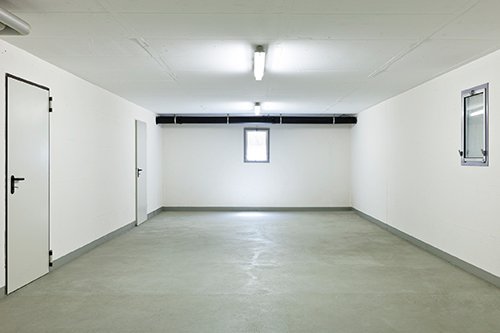Painting a basement floor is an excellent way to give your basement a mini-makeover. A new coat of paint can transform the look of your basement while the acrylic coating can also make the concrete floor easier to clean and improve its durability.
A home improvement project like painting your concrete basement floor and adding a floor coating is a fairly intense DIY project. From the type of epoxy paint, the kind of resulting floor coating, the drying time, adding a second coat, ensuring you’ve performed the correct patching of any cracks and using a degreaser to completely clean the prep surface. It’s important to keep the temp of the room between 50 and 90 degrees Fahrenheit.
Using the correct tools such as paintbrush or a paint roller cover part of what you’ll need, but painter’s tape, sandpaper, filler, concrete sealer, acid stain, epoxy, two-part epoxy, and the correct epoxy paint or other epoxy floor products go into this, and while some can be purchased on Amazon or local retailers there can be products that only professionals normally have access to.
All of the cleaning, prep work, patching and more lead to having a beautiful top coat, and if any part of the process is skipped or done correctly it can lead to even more work. This makes this one heck of a do it yourself project, and there are step-by-step processes you’ll need to follow on how to paint a concrete floor.
If you’re a homeowner who would like to paint your basement floor, these tips will help. These are not meant to be a tutorial in basement or garage floor paint, but can give some guidance for this fun interior painting project.
1. Pick the Right Color
Choosing the right color is the first important step in painting your basement floor. To pick the right color, consider the amount of light in the room and the amount of dirt that you expect to track in on a regular basis.
In a room where dirt is a common problem, a floor painted in a medium-to-dark color will help hide any tracks made by messy shoes. In a room where there’s little natural light, a lighter color paint can help brighten the space. Neutral colors like gray and beige are best for matching furniture and items placed in the room.
2. Clean the Floor
Before you can paint the floor, you’ll first need to clean it. Sweep the floor with a broom, then use a mop to wipe down the floor and remove any remaining dirt. Mop the floor with warm water mixed with gentle detergent or degreaser. Give the floors at least 24 hours to dry before proceeding.
If the basement is very humid, you may need to wait longer before painting. To find out, lay down a square of plastic on the floor overnight, then return the following day. If the plastic is wet underneath, this is a sign that the floor has not yet completely dried. You may either wait until the floors have completely dried, or run a dehumidifier in the room. Having it completely drys vital when you go to apply epoxy or basement floor paint, and why waterproofing can be so important.
3. Fix Cracks
Cracks allow moisture to enter the room, which can cause a painted floor to peel and bubble. Before painting your floor, patch cracks with a quality concrete patch. To do this, remove any rubble inside the crack, then fill the crack with a concrete patch. Use a paint scraper to level the paint.
Note that some cracks can be an indication of foundation trouble. If your basement floor has cracks wider than about 1/2 of an inch, talk to a structural engineer before covering the crack with a patch. A good structural engineer can help you decide whether or not your foundation cracks are indicative of a foundation problem.
4. Prime First, Paint Last
Paint has a hard time adhering to certain types of paint and concrete. The best way to ensure that your paint will stick to the concrete without peeling or bubbling is to paint the concrete slab floors with a concrete primer.
Follow all manufacturer instructions when applying primer to the floors. If you’ve recently patched cracks on your floor, check the crack patch directions to find out if there is a curing time before applying primer over the crack patch.
5. Choose the Right Paint
Basement floors need to be painted with floor epoxy, which is not quite the same as standard interior paint. Contact your local paint store or painting professionals to ensure that you’re able to buy the right type of paint for your basement. Low-VOC paint is good for basements because these spaces are not usually well ventilated. Low-VOC paint can reduce emissions in your basement and, therefore, keep indoor air quality as good as can be expected.
6. Contact a Professional Painter for Help
The best way to get your basement floor painted is to contact a professional painter. To get a quote or to get started with your floor painting project, contact a reputable painter in your community.
At Elite Painting KC, we’re happy to answer any questions you might have about flooring ideas and painting your basement or stained concrete floors. Contact us today to find out more about painting your basement floor.


